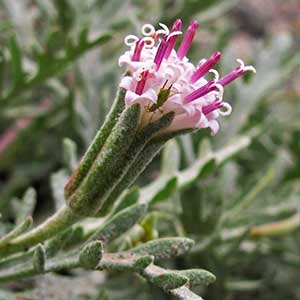Chaenactis douglasii
Chaenactis thompsonii
chaenactis, Douglas' dusty maidens, Douglas' dustymaiden, hoary chaenactis, hoary false-yarrow, hoary pincushion
Thompson's pincushion
1–25+, erect to spreading.
mostly 5–15+, ascending to erect.
basal, or basal (sometimes withering) and ± cauline, (1–)2–12(–15) cm;
largest blades ± elliptic or slightly lanceolate to ovate, ± 3-dimensional, usually 2-pinnately lobed;
primary lobes (4–)5–9(–12) pairs, ± congested, scarcely imbricate, ultimate lobes ± involute and/or twisted.
mostly cauline, 2–5 cm;
largest blades ± elliptic, ± plane, 1-pinnately lobed;
lobes mostly 2–5 pairs, remote, ± plane.
mostly ascending to erect, 1–10 cm.
ascending to erect, 2–5 cm.
obconic to ± hemispheric.
± obconic.
5–8 mm.
7–9 mm.
longest 9–15(–17) mm;
outer usually stipitate-glandular (sometimes sparsely or obscurely, rarely eglandular) and, often, arachnoid to lanuginose and, sometimes, sparsely villous, apices usually ± squarrose, pliant.
longest (10–)12–15 mm;
outer closely lanuginose, not stipitate-glandular, apices erect, ± rigid.
1–25+ per stem.
mostly 1–3 per stem.
5–8 mm (usually sparsely glandular amidst other indument);
pappi: longest scales 3–6 mm.
7–9 mm (eglandular);
pappi: longest scales 3.5–5 mm.
Chaenactis douglasii
Chaenactis thompsonii
Varieties 2 (2 in the flora).
Chaenactis douglasii is widespread and variable (see discussion under var. douglasii).
(Discussion copyrighted by Flora of North America; reprinted with permission.)
Of conservation concern.
Chaenactis thompsonii appears to be sister to C. evermannii; it is known from the mountains of central and northwestern Washington. The similar habits of C. thompsonii and C. ramosa (= C. douglasii var. douglasii) appear to result from convergent evolution in the distinctive habitat of their type localities (Wenatchee Mountains), not from a close genetic relationship as suggested by Cronquist.
(Discussion copyrighted by Flora of North America; reprinted with permission.)
1. Leaves basal (sometimes withering) and ± cauline; plants not or scarcely cespitose, not matted; stems usually 1–5(–12); heads (1–)2–25+ per stem | var. douglasii |
1. Leaves strictly basal; plants cespitose or ± matted; stems (1–)10–25+; heads 1(–2) per stem | var. alpina |
- Local floras:
BC,
CA,
OR,
WA
- Local Web sites:
CalFlora,
CalPhotos,
Flora NW,
PNW Herbaria,
Turner Photog.
WildflowerSearch
iNaturalist (observations)
USDA Plants Database
- LBJ Wildflower Center
- SEINet
- Plants of the World Online
- Encyclopedia of Life
- Wikipedia
- Google Image Search


